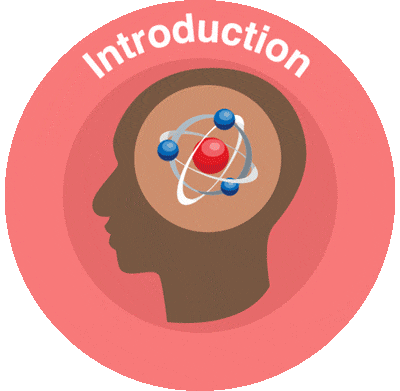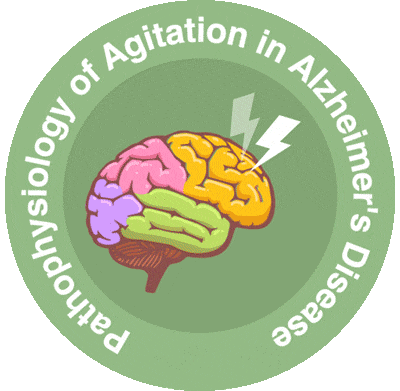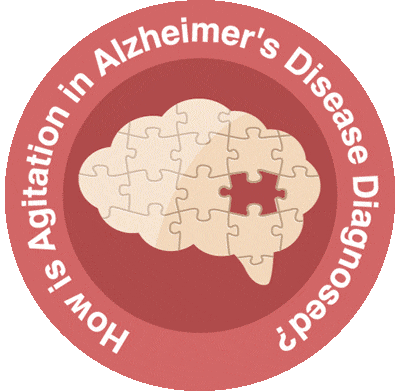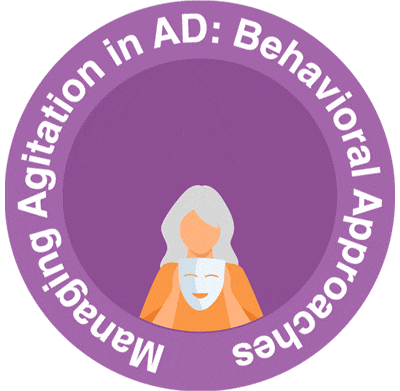
Pathophysiology of Agitation in AD
Agitation in patients with Alzheimer’s disease (AD) is thought to be related to dysfunction of the frontal lobe, the result of neurofibrillary tangles in the orbitofrontal cortex and anterior cingulate cortex observed in post-mortem studies of patients.1,3 In addition to postmortem findings, functional imaging studies show blood hypoperfusion in the anterior temporal lobe, dorsal lateral prefrontal cortex, and superior parietal cortex, as shown in the figure below.2,4
These changes may contribute to increased levels of aggression or agitation by interfering with brain areas responsible for thinking, planning, sensorimotor integration, and processing of environmental and social stimuli.1,4
These changes also impact multiple neurotransmitters, including serotonin, dopamine, and noradrenaline.5
Serotonergic deficiency. Reductions in 5-HT (serotonin) have been associated with hostility, impulsivity, and aggression in other neuropsychiatric patient populations.5
Dopamine. The relative preservation of dopaminergic function in the context of diminished cholinergic activity could underlie psychotic symptoms in AD, while such preservation in the context of diminished serotonergic activity in certain brain regions has been linked to aggressive or impulsive behaviors.5
Noradrenaline. The central noradrenergic system regulates arousal and autonomic function. There is some evidence implicating hyperactivity of this system in agitation and aggressive behaviors in patients with AD.5
Neuropeptide Y. Neuropeptide Y (NPY), a neurotransmitter believed to play a role in anxiety, reduces noradrenergic activity. Therefore, low NPY could enhance the noradrenergic contribution to agitation.5
Neuroinflammation in the medial temporal region and its neighboring area is also associated with the development of agitation symptoms in patients with AD.6
Defining agitation in Alzheimer’s disease
The most common features of agitation in Alzheimer’s disease are restlessness, nervousness, irritability, and a persistent sense of unease.7–9 Cohen-Mansfield and Billig proposed a definition of agitation in 1986 that Cohen-Mansfield expanded in 2008 as “inappropriate verbal, vocal, or motor activity not judged by an outside observer to result directly from perceptible needs or confusion of the agitated individual.”10,11
Symptoms of agitation may manifest with abnormal motor behaviors, including pacing, as well as inappropriate verbal, vocal, or motor activity. Socially inappropriate disinhibition, wandering, and repetitive motor movements may also be present.7-9
Specific categories of agitation, which include physical and verbal nonaggressive as well as aggressive features.12 The severity of symptoms varies by the disruptiveness, type, and frequency of behavior.
References
- Esteban de Antonio E, López-Álvarez J, Rábano A, et al. Pathological correlations of neuropsychiatric symptoms in institutionalized people with dementia. J Alzheimers Dis. 2020;78:1731-1741.
- Carrarini C, Russo M, Dono F, et al. Agitation and dementia: Prevention and treatment strategies in acute and chronic conditions. Front Neurol. 2021;12:644317.
- Rapp MA, Schnaider-Beeri M, Purohit DP, Perl DP, Haroutunian V, Sano M. Increased neurofibrillary tangles in patients with Alzheimer disease with comorbid depression. Am J Geriatr Psychiatry. 2008;16:168-174.
- Weissberger GH, Melrose RJ, Narvaez TA, et al. 18F-Fluorodeoxyglucose positron emission tomography cortical metabolic activity associated with distinct agitation behaviors in Alzheimer disease. Am J Geriatr Psychiatry. 2017;25:569-579.
- Liu KY, Stringer AE, Reeves SJ, Howard RJ. The neurochemistry of agitation in Alzheimer’s disease: A systematic review. Ageing Res Rev. 2018;43:99-107.
- Yasuno F, Kimura Y, Ogata A, et al. Involvement of inflammation in the medial temporal region in the development of agitation in Alzheimer’s disease: An in vivo positron emission tomography study. Psychogeriatrics. 2023;23:126-135.
- Cerejeira J, Lagarto L, Mukaetova-Ladinska EB. Behavioral and psychological symptoms of dementia. Front Neurol. 2012;3:73.
- Borisovskaya A, Pascualy M, Borson S. Cognitive and neuropsychiatric impairments in Alzheimer’s disease: current treatment strategies. Curr Psychiatry Rep. 2014;16:470.
- Koenig AM, Arnold SE, Streim JE. Agitation and irritability in Alzheimer’s disease: Evidenced-based treatments and the black-box warning. Curr Psychiatry Rep. 2016;18:3.
- Cohen-Mansfield J, Billig N. Agitated behaviors in the elderly. I. A conceptual review. J Am Geriatr Soc. 1986;34:711-721.
- Cohen-Mansfield J. Agitated behavior in persons with dementia: The relationship between type of behavior, its frequency, and its disruptiveness. J Psychiatr Res. 2008;43:64-69.
- Cohen-Mansfield J. Measurement of inappropriate behavior associated with dementia. J Gerontol Nurs. 1999;25:42-51.









